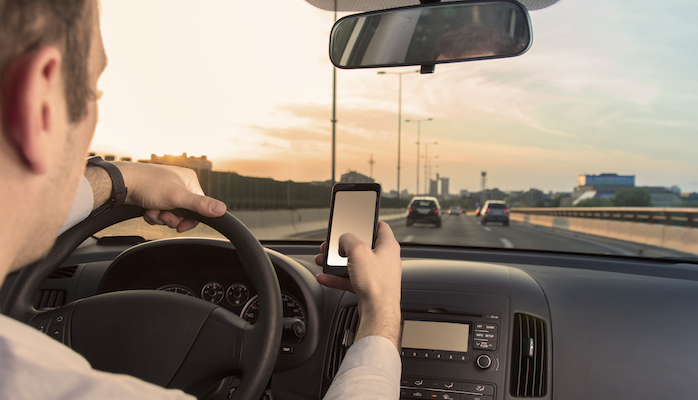
26 Mar The Role of the Connected Car in Driver Safety
According to a recent study by BI Intelligence, people spend an average of 6.5 hours per week in their cars. In today’s world, people want to be connected at all times and unfortunately they frequently interact with their phones while driving. The rising popularity of wearable and IoT devices like the Apple Watch present a similar, largely unregulated problem in adding to driver distraction. There are 330,000 injuries per year caused by distracted drivers’ texting and taking their eyes off the road to respond to information on their sma rtphones. With 1.7 billion cars expected to be on the road by 2035, limiting driver distractions is crucial.
rtphones. With 1.7 billion cars expected to be on the road by 2035, limiting driver distractions is crucial.
The explosive growth of smartphones and new IoT devices has consistently stayed ahead of the laws that are meant to keep up with driver distraction. Today nearly every state in the US and providence in Canada have begun passing laws that are designed to convince people to refrain from interacting with their devices while driving or risk paying steep fines. The problem is that we know people either don’t understand the risk, assume it won’t happen to them or are not deterred by the punishment, because driver distraction continues to be a growing reality.
Lawmakers are trying to solve the problem. However, most laws are either unable to keep up with technological advancements or the laws are very difficult to enforce. While I support the continued strengthening of our smartphone and IoT distracted driving laws, I don’t believe that laws are enough to solve the problem sure to get worse. We need to do more.
The answer is for the industry is this: make better, more integrated connected cars. This requires manufactures and the makers of connected car software to work together toward the achievable goal of delivering safe connected driving experiences. Our industry is committed to ensuring driver safety in our mobile era by designing solutions that integrate the smartphone into the onboard computer of the car and enabling communication with the driver through the vehicle head unit. This scenario lets consumers enjoy the familiar experience offered by their smartphone, yet ensures a safer driving experience. The result is a richer, more complete solution that reduces driver distraction.
As a point of comparison, consider a driver using a smartphone or smartwatch for directions. The driver must take his or her eyes off the road to look down at the device to see where the next turn occurs. The driver will frequently need to consult a different app to check traffic patterns, parking options or whether or not another party is running late to a meeting. With a connected car solution that integrates with existing apps on a driver’s device, the vehicle head unit can offer the most efficient route based on traffic patterns, notify the driver of parking options at the final destination, and even alert the driver if another party is running late to a meeting. Most importantly, through audio and heads-up displays, these tasks can be completed without the driver having to take his or her eyes off the road. The connected car offers an opportunity to be more efficient and provide drivers with necessary information as quickly as possible.
Strides have already been made in the industry for ensuring driver safety. The National Transportation Safety Board (NTSB) has created guidelines for auto manufacturers as they design connected experiences in their cars, such as restricting Web browsing to when a car is parked or limiting the time drivers need to take their eyes off the road to complete a task. Toyota has also put driver safety first by simplifying driver interactions using conversational voice recognition and in-vehicle controls, which allow the driver to focus on the road instead of on his or her phone. Voice and audio commands and instructions are just the beginning of in-car technology innovations. Cars in the not-so-distant future will implement heads-up displays, retina tracking and/or gesture commands. Vehicles will even wirelessly interact with one another to prevent accidents.
Until we reach a world of fully autonomous cars, we need to keep pursuing ways of connecting the car in less distracting ways. Today that means focusing on safely connecting the smartphone to the car, but to really reduce the risk of driver distraction, the car should connect itself to applications in the cloud through its own wireless connectivity. Only then can the phone be left where it truly belongs: safely out of reach in a briefcase or bag. In essence, cars need to evolve to become standalone, connected devices optimized for safe driver interaction in order to decrease the risk of accidents on the road.
Driver distraction is far too important to our society for us to wait for laws to be created or for drivers to do the right thing. I think that we can all agree that drinking and driving laws have not eradicated the problem of drunk driving and auto accidents. Instead, we need to deliver a safer connected car experience to really have a meaningful impact on this important issue. We are committed to enhancing consumers’ digital lifestyles in a safe and secure manner. By focusing on efficient experiences through interactive, user-friendly applications and platforms, we have been able to offer experiences that support driver focus on the road.
For more in-depth analysis of in-car technologies, I recommend the following white paper:, “The In-Car App Experience: Convergence and Integration,” which highlights the opportunities and setbacks for auto manufacturers, OEMs and software developers in the connected-car market. To read our original post about this, please click here.







